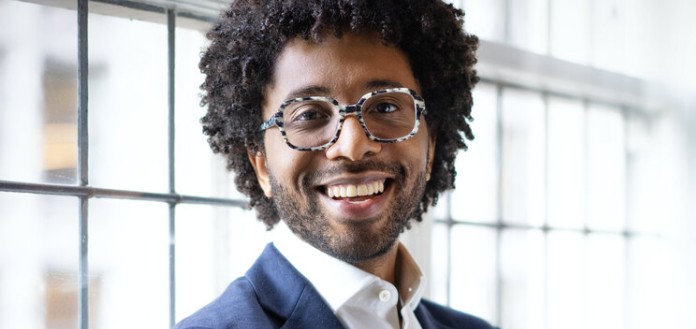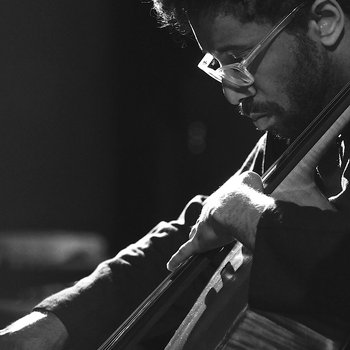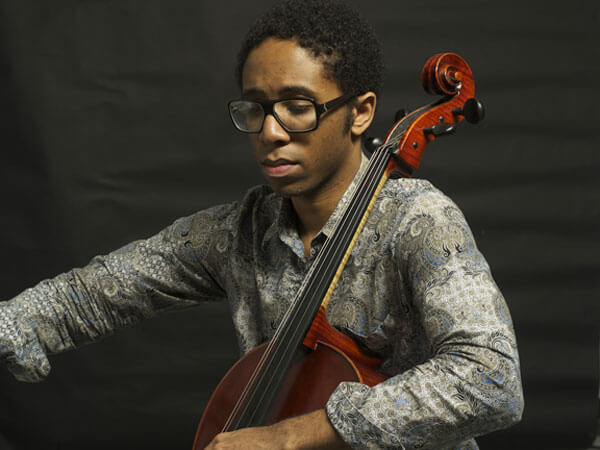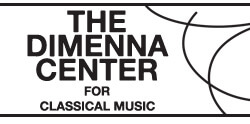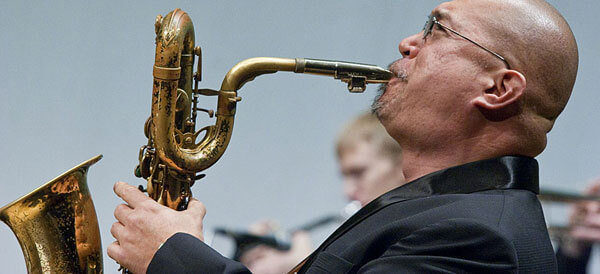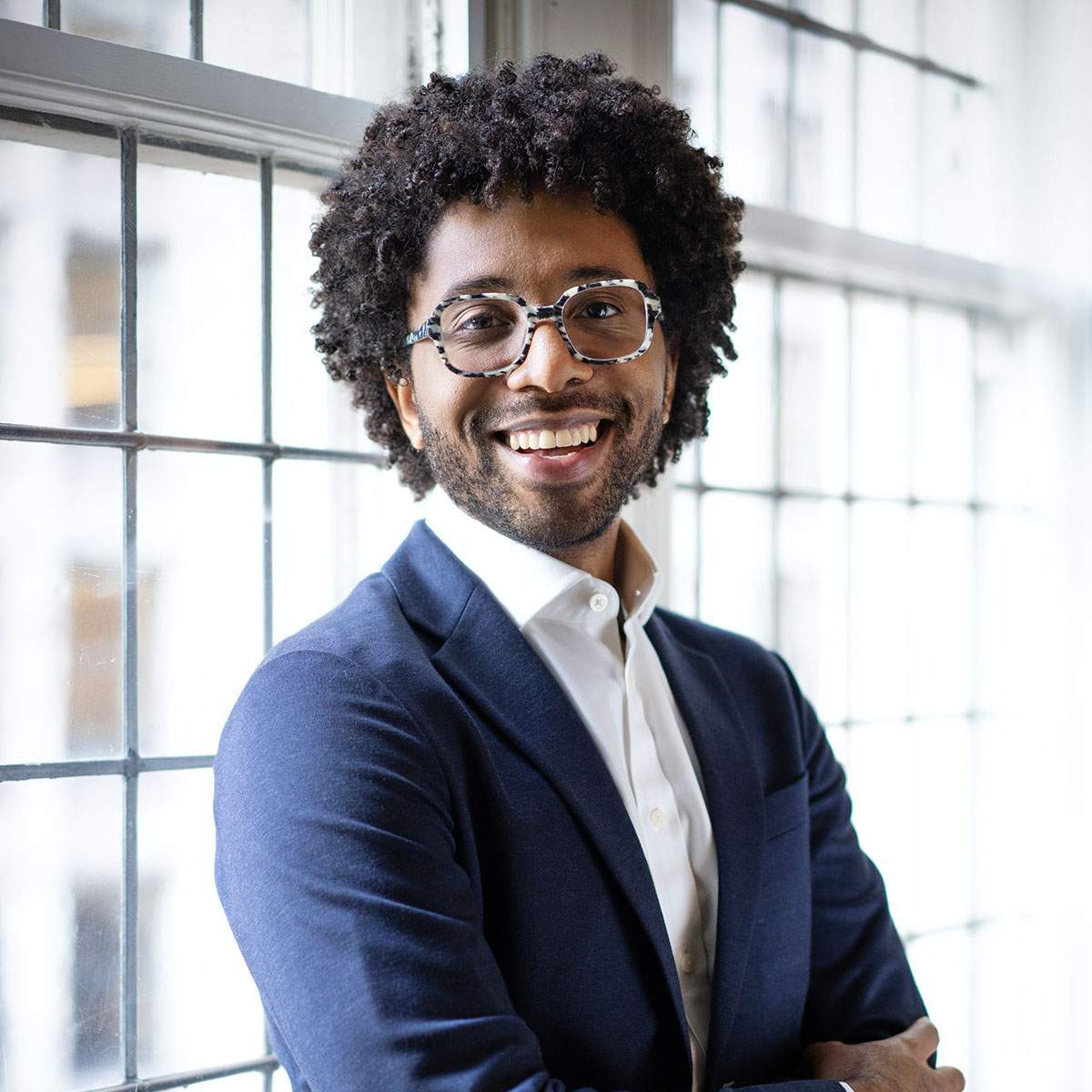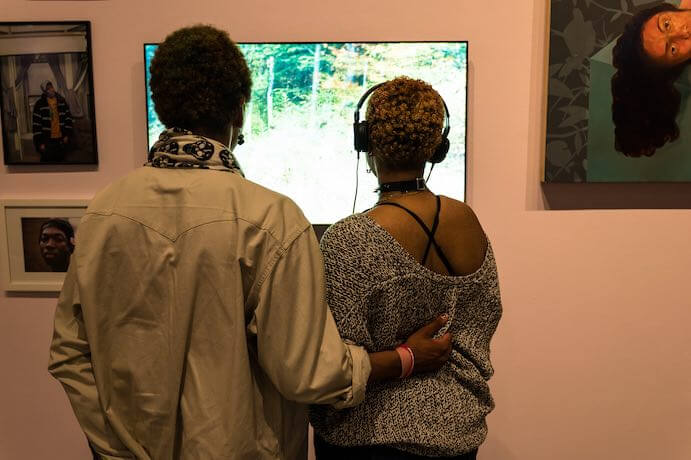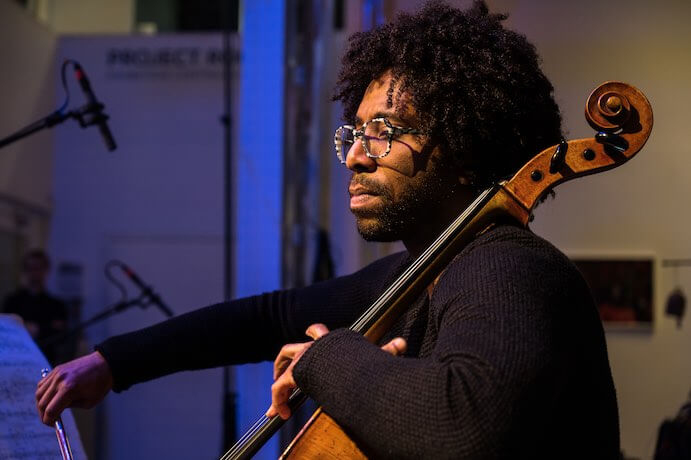
SOUND PROJECTIONS
AN ONLINE QUARTERLY MUSIC MAGAZINE
EDITOR: KOFI NATAMBU
WINTER, 2021
VOLUME NINE NUMBER THREE
FARUQ Z. BEY
Featuring the Musics and Aesthetic Visions of:
William Parker
(January 23-29)
Jason Palmer
(January 30-February 5)
Living Colour
(February 6-12)
Charles Tolliver
(February 13-19)
Henry Grimes
(February 20-26)
Marcus Strickland
(February 27-March 5)
Kendrick Scott
(March 6-March 12)
Seth Parker Woods
(March 13-19)
Christian Sands
(March 20-26)
Ulysses Owens
(March 27-April 2)
Steve Nelson
(April 3-9)
Steve Wilson
(April 10-16)
https://sethparkerwoods.com/About
SETH PARKER WOODS
In the 2020-21 concert season, Woods will make debuts at EMPAC, The Strathmore, LACMA in Los Angeles and the Spoleto Festival. This season of performances will also include premiere performances of concertos by Tyshawn Sorey with the Seattle and Atlanta Symphony’s (David Robertson and Maxim Emelyanychev, conductors), and the late Fausto Romitelli with John Kennedy and the Spoleto Festival Orchestra. Woods will serve as the new 2020-21 Artist in Residence for the Kaufman Music Center in New York City, as well as guest artist at the Juilliard School, University of Iowa, University of Vancouver, Stanford University, Boston Conservatory, Ammerman Center for Arts and Technology at Connecticut College and Northwestern University - Center for New Music.
In recent years, Woods has appeared in concert at the Royal Albert Hall—BBC Proms, Snape Maltings Festival, the Ghent Festival, Musée d’art Moderne et Contemporain, Le Poisson Rouge and the Bohemian National Hall, Cafe OTO, Huddersfield Contemporary Music Festival, Klang Festival-Durham, INTER/ actions Symposium, ICMC-SMS Conference (Athens, GR), NIME-London, Sound and Body Festival, Instalakcje Festival, Virginia Tech, La Salle College (Singapore), and FINDARS (Malaysia), among others. Recent awards include a DCASE artist grant, Earle Brown/ Morton Feldman Foundation Grant, McGill University-CIRMMT/IDMIL Visiting Researcher Residency, Centre Intermondes Artist Residency, Francis Chagrin Award, Concours [Re]connaissance-Premiere Prix, and the Paul Sacher Stiftung Research Scholarship.
His debut solo album, asinglewordisnotenough (Confront Recordings-London), has garnered great acclaim since its release in November 2016 and has been profiled in The New York Times, Chicago Tribune, LA Times, The Guardian, 5against4, I Care If You Listen, Musical America, Seattle Times, and Strings Magazine, amongst others.
Woods serves on the performance faculty at the University of Chicago as a Lecturer/Artist in Residence for Cello and Chamber Music. He previously served on the music faculties of Dartmouth College and the Chicago Academy of the Arts, and holds degrees from Brooklyn College, Musik Academie der Stadt Basel, and a PhD from the University of Huddersfield. At present, he is the Artist in Residence with the Kaufman Music Center, and former AiR with Seattle Symphony and the interactive concert hall, Octave 9: Raisbeck Music Center.
by Thomas May
Strings Magazine
“Question authority” isn’t just a political slogan. This quintessentially Socratic imperative is also characteristic of visionary artists who are drawn to challenge cultural assumptions that put a damper on the power of the art they practice. For Texas-born cellist Seth Parker Woods, pushing boundaries and definitions comes naturally—both for his own creative development and for his overall sense of mission.
“I’m trying to change the face and the landscape in which music can be experienced, regardless of class or ethnicity or background,” Parker Woods says during a phone interview in May from his home base in Chicago, shortly before heading abroad for a solo engagement in Athens as part of the internationally prestigious documenta 14 exhibition of contemporary art. “So I’m making art in any way possible, whether it’s a familiar recital format or a concept of the cello that brings the instrument into the visual-arts medium.”
As a corollary of his mission to rethink the performer’s role, Parker Woods refuses to let his identity as a cellist be restricted by conventional perceptions of what a classical string player does. Which is why, even at this still-early stage of his career, he’s already been leaving his imprint on a fascinating variety of collaborations across disciplines.
An increasingly frequent and welcome presence among new-music circles, Parker Woods also draws audiences from the spheres of dance and innovative visual arts. And while the cello is at the center of his creative work, it shares space with his ongoing explorations of kinesthetics and the body, choreography, electronic music, visual art, and theatrical performance. Parker Woods is just as likely to be found performing in an unusual architectural setting—as he did in the reopened turbine tanks of the Tate Modern for the 2012 retrospective of Aldo Tambellini—as indulging his obsession with cello music from the 17th-century Italian Baroque (which his friend Elinor Frey, the Montreal-based Baroque cellist, awakened for him).
This month finds Parker Woods performing in a characteristic variety of concert-hall and unconventional contexts. On August 12, the Arts Club of Chicago presents the premiere of ICED BODIES: Music for Chicago, a performance installation in which he joins forces with the American artist and composer Spencer Topel. ICED BODIES is Parker Woods’ contemporary reframing of a legendary avant-garde collaboration from 1972 between the maverick designer Jim McWilliams and the late cellist and performance artist Charlotte Moorman. The original version was a durational “happening,” in the spirit of the Fluxus movement (an avant-garde art movement that took shape in the 1960s and ’70s) that involved Moorman using a saw and other tools to play a cello sculpted from ice as it melted. Parker Woods’ project draws on that performance while bringing it into the 21st century.
At the end of August, Parker Woods heads to London’s Royal Albert Hall to perform with the Chineke! Orchestra for its debut at the BBC Proms on August 30. He’s one of the founding cellists of this ensemble, which was created to address the underrepresentation of ethnic minorities among Europe’s professional orchestras. The Chineke! Orchestra’s program includes the first-ever Proms performance of music by American composer George Walker (who was featured in last month’s issue of Strings magazine).
“My upbringing is in classical, and that’s still a major part of my career. But I feel that we as performers have to usher in the music of now and be advocates for it,” Parker Woods says. “Luckily we are living in a period of time when there are so many different composers writing such a wide spectrum of music. And there’s an audience for it.” In other words, Parker Woods adds, the days when all contemporary pieces were considered “inaccessible modern music” are behind us.
Affirming “the music of now,” for Parker Woods, is a part of his mission to expand the image of a classically trained cellist in the 20th century. Trying to find a way to label what he does misses the point. “I don’t describe myself as a performance artist or a cellist or a ‘contemporary cellist.’ I’m flexible enough to be able to float between many different types of voices of composers telling their stories. That’s where I position myself.”

Chineke Orchestra. Photo by Zen Grisdale
As a boy in his native Houston, where he was born in 1984, Parker Woods recalls falling in love with the sound of the cello when he saw the film The Witches of Eastwick. In one over-the-top scene of this comedy-fantasy, based on a John Updike story, Susan Sarandon plays the instrument with Jack Nicholson at the piano until her cello bursts into flames. Parker Woods started lessons at age five or six. “My father was a gospel and jazz singer, and had a band that would rehearse in our basement studio. My earliest musical experiences came from listening to them rehearse when I was a toddler, and from the records and 8-track tapes he and my mom would play.”
Along with the performer’s drive for expressive communication, Parker Woods possesses the intrepid curiosity of an original thinker and scholar. His training on the cello has intersected with an intriguing academic career, leading him to work with a remarkably diverse roster of mentors over the years. He was accepted into a preparatory program at Juilliard, where cellist André Emelianoff became instrumental in his development. After completing the program at Houston’s High School for the Performing and Visual Arts—Robert Glasper and Beyoncé number among its graduates—Parker Woods finished his undergraduate studies at the Brooklyn College Conservatory of Music with Frederick Zlotkin (principal cello of New York City Ballet and brother of Leonard Slatkin).
“Dance was important to me as a kid, and I already had a connection to musicians who were involved in this medium,” he recalls. “After college I stayed in New York trying to find a way to blend classical and contemporary.” During this period Parker Woods began playing on tours with such popular artists as Peter Gabriel, Lady Gaga, Adele, Sting, and the late Lou Reed, as well as subbing with the Orchestra of St. Luke’s.
A connection to opera, ballet, and film composer Patrick Soluri opened the door to Europe, which has remained a major focus of Parker Woods’ career as a performer and scholar. Through Soluri, he was engaged to perform in the Berlin Staatsballett orchestra. He later worked with the contemporary choreographer Anne Teresa De Keersmaeker and P.A.R.T.S., the dance academy of her company Rosas. A residency at the Centre Intermondes in La Rochelle, France, led to several more collaborations.
“I just kept breaking all the rules,” says Parker Woods. He wrote out-of-the-blue to the adventurous composer and cellist Thomas Demenga in Basel, was invited to audition, and got accepted into his studio, where he completed a master’s program for soloists and musicians specializing in contemporary music. Living in several different countries in Europe, Parker Woods completed his PhD thesis at the University of Huddersfield in the UK.
At Huddersfield he chose a topic that combined both his scholarly and performance interests. In fact, Parker Woods’ thesis provided the basis for a landmark achievement in his performance career, from which he continues to draw. “My thesis is titled Almost Human: The study of physical processes and the performance of a prosthetic spine. My research looked at subjective movement and intention in musicians and dancers, and used the data and understanding from case studies related to the classical and contemporary music canon to create new works for cello, dancer, and electronics (also titled Almost Human).”
Parker Woods also synthesized ideas gleaned from his collaborations with groups across the Channel. In Belgium he spent time with the Ictus Ensemble, which toured with a project involving students from their Academy and the Royal Conservatory of Ghent. This work involved “kinesthetics and trying to find ways to understand movement as physicalized or compositional gestures between musicians and dancers,” Parker Woods says.
While in Switzerland, Parker Woods rekindled a longstanding interest in electronics thanks to the encouragement of trombonist and composer Mike Svoboda—himself a protege of Stockhausen. Parker Woods recently channeled this into his highly experimental debut album a single word is not enough (released in 2016 on the London-based label Confront Recordings). Stretching the definition and image of the cello itself, the album features premiere recordings of works by Michael Clarke, Edward Hamel, George Lewis, and Pierre Alexandre Tremblay—three of which were composed for Parker Woods.
“I just kept breaking all the rules.”
—Seth Parker Woods
Early in 2016, after another stay in New York to participate in Invisible Thread, a musical about connections between artists in Ghana and the West (the work of Griffin Matthews and Matt Gould, which was staged by Second Stage Theatre), Parker Woods relocated to Chicago. “So many other new music groups had popped up while I was in England. It’s become an even more vibrant city, with a beautiful community that supports groups for all types of creative crafts,” he says.
As an example, Parker Woods cites the convergence of personalities that inspired him to undertake his ICED BODIES project, which he initially conceived while studying in Basel. The exhibition “A Feast of Astonishments: Charlotte Moorman and the Avant-Garde, 1960s–1980s” at Chicago’s Mary and Leigh Block Museum of Art was a spur. “I’ve been a big fan of the Fluxus art movement and how these artists challenged institutional practices,” he says. Parker Woods was able to meet with Jim McWilliams (now retired in Santa Fe), who had created the ice cello for Moorman. He also received encouragement from former Kronos cellist Joan Jeanrenaud, who revived Ice Cello in 2004.
“Now is the time to do this piece, I realized. In some ways I could say I’ve appropriated part of the original, but am keeping true to the core of what Jim McWilliams envisioned and designed. But I’m also doing it in my own way to bring it into 2017. I decided to highlight and salute the topic of mental disability. I’m always interested in the homeless and how they get to that point. So I designed a conceptual performance installation. ICED BODIES is an ephemeral, long-duration work using some of the ideas of McWilliams but pushing it further. The sound of the dripping and crackling ice is amplified, electronically processed, and diffused through glass sound sculptures, and a beautiful, striking obsidian-colored cello.”
The new season promises an even wider range of activity. Along with several more performances of Morton Feldman’s modernist classic Patterns in a Chromatic Field (which he performed earlier this year with pianist John Snijders at Durham University in England), Parker Woods will give a series of duo recitals with the French-American pianist Julia Den Boer, combining works by Clara Schumann with envelope-pushing modern pieces for cello. In 2018 he will serve as artist-in-residence at Dartmouth College, and make several debuts, including at the Cluster Festival in Winnipeg with a program that features a new work by Cassandra Miller. September brings the release of Trajectories (on the Recital label out of Los Angeles), an album on which Parker Woods is joined by pianist R. Andrew Lee to perform music for cello and piano by the young New York–based composer Michael Vincent Waller.
“When
I reach 70, I want to look back on my career and be able to say it was
fun and that I didn’t do just one thing,” Parker Woods says. “There’s
nothing wrong with devoting a life to one style and genre. For me, my
life has been filled with so many different types of experiences
culturally. But I’m just an artist responding to what I know. I hope the
legacy I leave behind will stand the test of time.”
Cellist Seth Parker Woods Brings Music into the Community
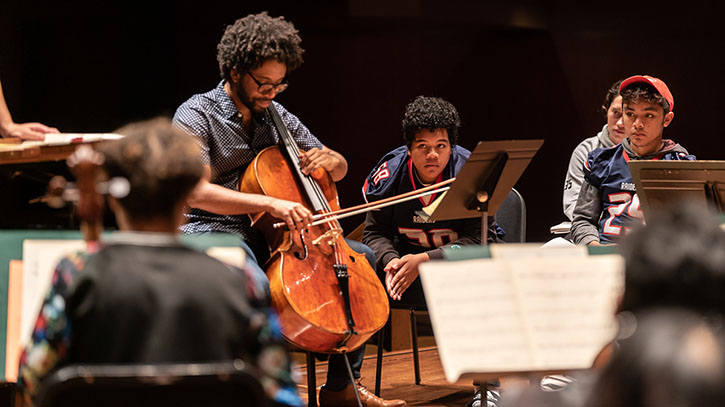
Seth Parker Woods performing Rebecca Saunder’s Ire Concerto for Cello and Ensemble at an Open Rehearsal. (Photo: James Holt)
The remarkable cellist will be the first-ever Artist in Residence for Octave 9: Raisbeck Music Center.
by Andrew Stiefel and James Holt
Cellist Seth Parker Woods has made a career of challenging boundaries, appearing with artists ranging from Peter Gabriel, Sting, Lady Gaga and Adele to performing at institutions including Carnegie Hall, Tate Modern, Royal Albert Hall and New York City Ballet.
Now his artistic adventure continues with the Seattle Symphony.
Parker Woods will be the first-ever Artist in Residence for Octave 9: Raisbeck Music Center,
the Symphony’s new venue for immersive musical experiences which will
open next March at Benaroya Hall. In preparation, Parker Woods spent a
week embedding himself into the Symphony’s community and education
projects earlier this fall.
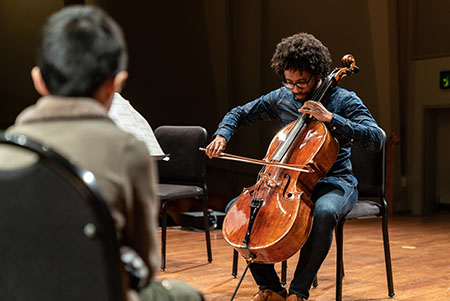
Seth Parker Woods performing at a youth-led panel discussion. (Photo: James Holt)
As a boy in Houston, Parker Woods recalls growing up in a home filled with music. His father was a jazz and gospel singer and his mother is a fan of ballet and opera. He recalls sitting on her lap on Sunday afternoons, listening to his father’s band rehearse.
But Parker Woods says that he was inspired to play the cello after watching The Witches of Eastwick, a 1987 film based on a novel by John Updike. “There’s this scene with Susan Sarandon’s character playing her cello until the instrument bursts into flames,” he laughs. “I was five at the time I saw the film and that seemed like exactly what I wanted to do.”
He started cello lessons shortly after with David Garrett, at the time a cellist with the Houston Symphony. Seth eagerly took in everything his teacher could offer. “He would make mixtapes for me of famous cellists and concertos, labeling everything on the cover for me. That was my guide and, really, my introduction to classical music and the cello.”
Even as he quickly embraced his instrument, Parker Woods remembers feeling out of place in the world of classical music. “There was no one who looked like me as a cellist, or even a string player, when I was growing up. I never saw an African American or even a Latino string player doing classical music on major concert stages,” he remarks. “So I looked to opera singers for role models, artists like Kathleen Battle, Leontyne Price, Jessye Norman and Denyce Graves.”
That’s partly why he has brought a community-first approach to his residency with the Seattle Symphony.
“We can invite people to attend concerts downtown but going out into the community is where it really matters and where it will make the most impact,” he explains. “These smaller spaces make one-on-one interaction possible, so you can share your story and talk about your journey, what it was like applying to school and starting a career.”
In October he performed two Community Concerts, hosted an Open Rehearsal and participated in a youth-led panel alongside fellow cellist Sheku Kanneh-Mason. “Giving concerts is only part of the job of a musician — you have to show up in other ways too,” says Parker Woods.
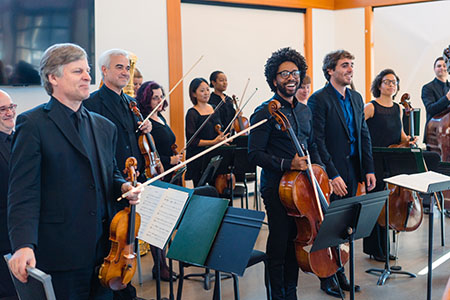 Seth Parker Woods performing with the Seattle Symphony at a Community Concert Tukwila, Washington. (Photo:Brandon Patoc)
Seth Parker Woods performing with the Seattle Symphony at a Community Concert Tukwila, Washington. (Photo:Brandon Patoc)
Committed to redefining the image of a classically trained cellist in the 21th century, Parker Woods has made it his personal mission to affirm the importance of music being created today, commissioning and championing a wide spectrum of music. And he brings a contagious enthusiasm to how he talks about new music, inviting the audience to fall in the love with it.
“I think people have to find themselves in a work,” he explains. “People can relate to music regardless of when it was written, but, for me, sharing these stories and these narratives about why a piece was created today, and why a composer responded a certain way, can help people reflect in a very different way.”
For the Community Concerts in Des Moines and Tukwila, he performed Rebecca Saunder’s Ire Concerto for Cello, Strings and Percussion with Associate Conductor Pablo Rus Broseta and a chamber ensemble of Seattle Symphony musicians.
It’s a challenging work for musicians and audiences alike and “isn’t what we’d typically program for a Community Concert or a group of high school students without an artist like Seth involved,” says Laura Reynolds, Seattle Symphony Vice President of Education & Community Engagement. “But his artistic vision and his lived experience collaborating with the composer herself inspired teens and community members alike to explore the ways that we can experience new ideas together.”
At the Open Rehearsal, students from Nathan Hale High School and Seattle World School joined Parker Woods and the Seattle Symphony on stage. Throughout the morning they interacted with the musicians and discussed the emotions of the music and how a composer translates an idea or feeling into notation on the page.
“Seth brings a joyful inquisitiveness and integrity to his work,” adds Reynolds. “His commitment to sharing and providing equitable access to art lays a solid foundation for us to build deeper connections to these communities over the next two years with him.”
Parker Woods will return for concerts in March after the grand opening of Octave 9 and will be Artist in Residence through the end of the 2019–2020 season.
“I am delighted that Seth has agreed to become the first
Artist in Residence for Octave 9,” says Elena Dubinets, Seattle Symphony
Vice President of Artistic and Creative Projects. “He will help us
feature the unique qualities of this space: the intimacy of experiencing
music in a non-traditional venue; the informal and accessible spirit of
concert presenting; and the pioneering partnership between live
instruments and electronics.”
Although the cello is always at the center of his creative work, Parker Woods also draws from connections to choreography, visual art and theatre in his performances. His residency will take full advantage of Octave 9’s one-of-a-kind capabilities, including surround video projections, motion-capture cameras and a state-of-the-art Meyer Sound Constellation® Acoustic System.
“Sometimes you don't have access to control the visual experience — it's only acoustic or electronic — so I've been able to dream big and develop something that is going to be extremely dynamic,” he says. “Octave 9 is the perfect playground and I can’t wait to continue the adventure.”
Plan your musical adventure in Octave 9: Raisbeck Music Center! Tickets are on sale now for concerts, talks and musical experiences for the entire family.
HCMF 2016: Seth Parker Woods, Ensemble Resonanz + Elliott Sharp + Gareth Davis
Friday at HCMF began with a recital by rising star cellist Seth Parker Woods. I’ve had the opportunity to see Woods play once before (at HCMF 2014)
and the experience was a highly impressive one, so I was very much
looking forward to seeing him in action again. He did not disappoint,
performing four challenging works, two of which involved live
electronics. The acoustic pieces occupied soundworlds of an intimate,
ephemeral nature. Alvin Singleton‘s Argoru II was
sufficiently gestural that it took on a pervasive arbitrariness that
frustrated engagement on anything but the most superficial level. Gray Neon Life by Edward Hamel
was similar but explored much more interesting alternations between
gesture and pitch with occasional fragments of a barely audible spoken
text. Nonetheless it, too, conveyed an aloofness that made its transient
filigree feel somewhat skin-deep. Despite these compositional concerns,
Wood’s performance of both pieces was seriously involving, exploiting
the intimacy to give the impression he was playing to every member of
the audience personally, and even at times as though he were playing
entirely to himself. George Lewis‘ Not Alone utilised
electronics to echo, distort, resonate, flitter and skitter around and
follow hot on the heels of the cello’s material. Structured as a clear
sequence of contrasting episodes, there was a delirious playfulness in
Lewis’ conveyor belt of wildly diverse musical offerings. As with all
but the very best works in the bloated
performer-does-something-and-computer-responds genre, there were times
when the hierarchical relationship felt simplistic, obvious and even a
trifle tired, but this was a minor shortcoming in an otherwise
thoroughly enjoyable and convincing piece. The unquestionable highlight of the concert, though, was Pierre Alexandre Tremblay‘s asinglewordisnotenough3 (invariant),
which provided both a composition masterclass in its seamless, aurally
non-hierarchical interaction between acoustic and electronic, as well as
a performance masterclass in its bravura display of frantic virtuosity
from Woods. The work’s narrative was excellent, progressing through a
series of evolving episodes each fuelled by the cello, many of them
rhythmically taut (though never sounding metrically fixed) with a
tendency later to expand out into more sustained soundscapes where the
cello’s material was more buoyant. Utterly thrilling, and Woods
unstoppable performance was outstanding.
Claudio Gabriele (1963*) - PNOM für solo Violoncello (1995) UA
At 7 minutes 30 seconds
Limpid Dance
The cellist Seth Parker Woods isn’t just a virtuoso on his instrument. He’s also got fantastic taste, whether he’s playing in electronic environments or acoustically, as he did in his program on Wednesday at the Italian Academy at Columbia University. Mr. Woods framed his free hourlong set there with two works by Giacinto Scelsi. But he built out the program with smart pairings, including lesser-known works like Claudio Gabriele’s “PNOM.” In a video of an earlier performance of that work, you get a sense of all the stops a composer can ask a player to pull out. Precisely controlled changes in bow pressure result in savagely screeching motifs, gentle harmonics, or else a stray passage of limpid dance. --SETH COLTER WALLS
From Lady Gaga to an ice cello, Seth Parker Woods redefines what it means to play cello
Performances by adventurous cellist Seth Parker Woods are not only ear-opening: They expand your perceptions of his instrument’s identity itself.
Performances by Chicago-based cellist Seth Parker Woods are not only ear-opening: They expand your perceptions of his instrument’s identity itself.
Local music lovers will get a chance to experience this extraordinary, adventurous young artist in person when he makes his Seattle debut Saturday, Dec. 9, in a solo recital at the Chapel Performance Space at the Good Shepherd Center in Wallingford.
Parker Woods was featured at the Arts Club of Chicago this past summer in “Iced Bodies,” a performance art collaboration with the experimental composer Spencer Topel, in which he played a cello sculpted from ice as it slowly melted and dripped. While no phase changes are planned for his solo Seattle recital, Parker Woods will augment the sound world he produces from his instrument with electronics and even a radically altered bow.
RECITAL PREVIEW
Nonsequitur presents Seth Parker Woods
8 p.m. Saturday, Dec. 9, Chapel Performance Space at the Good Shepherd Center, 4649 Sunnyside Ave N, Seattle; $5-$15 donation at door (nseq.org).
Most of the program Parker Woods has in store for Seattle comes from his debut album, “asinglewordisnotenough.” Released last year on the London-based Confront label, the album represents “the culmination of collaborative work I’d been doing for the past five or so years,” the cellist explained in a recent phone interview. “It’s the first sonic archive I’ve been able to create documenting me as I explore my relationship to the instrument.”
All of the works he has chosen are by living composers and will be Seattle premieres; three of them were written specifically for the 33-year-old Parker Woods, who was featured as Musical America’s New Artist of the Month in October.
For example, the Québécois composer and bass guitarist Pierre Alexandre Tremblay wrote the album’s title piece, “asinglewordisnotenough,” while Parker Woods was researching his Ph.D. thesis at the University of Huddersfield in the United Kingdom.
“In that piece, the singular voice of the cello is multiplied into a maximum of eight, scattered and speckled throughout the work. One of the things I was researching at Huddersfield was physical gesture while playing the cello and how to translate that into a kind of meta-instrument,” Parker Woods says. “My introduction to the use of electronics outside of dance or pop music came with the Miles Davis of ‘Bitches Brew’ and later when I started getting into Edgard Varèse and Karlheinz Stockhausen.”
A native of Houston, the cellist was inspired to learn his instrument at the age of 5 after seeing the film “The Witches of Eastwick,” which includes a scene with Susan Sarandon playing ever more passionately, until her cello bursts into flame. Parker Woods attended Houston’s High School for the Performing and Visual Arts. He spent formative periods in New York and Europe, at one point making a living playing side gigs with Lady Gaga and Sting.
In Europe, Parker Woods combined his passions for experimentation and dance and came under the influence of the legendary choreographer Anne Teresa De Keersmaeker. His dissertation addressed the aesthetics of movement among musicians and dancers, culminating in an interactive work using a “prosthetic digital spine,” which Parker Woods titled “Almost Human.”
Another piece, “Gray Neon Life,” is by the young American composer Edward Hamel and came about after Parker Woods sent out a call for compositions responding to urban street art. Hamel references the graffiti tags made famous by the artist Jean-Michel Basquiat, incorporating fragmented phrases into his score that are spoken by the cellist. Although purely acoustic, “Gray Neon Life” radically alters the cello’s sound by using a bow whose hair is twisted around the stick — a technique devised by the Australian composer Liza Lim. “It creates this serrated, fraying sound that you hear almost as a stutter,” Parker Woods said. “I think of it as a retranslation of speech patterns, like you find with MCs and in hip-hop.”
The program’s experimental focus reflects the mission of Nonsequitur. Says Steve Peters, the director of the series and an admired linchpin in Seattle’s new-music scene: “I was specifically interested in Seth because he is playing composed music that pushes the boundaries of his instrument, combining acoustic cello with complex electronics.”
But his artistic practice embraces the classic repertoire as well. When Parker Woods made his debut in October at the prestigious Phillips Collection Sunday concert series in Washington, D.C., he opened the program with the first of Bach’s revered Cello Suites. He is also a founding cellist of Chineke!, Europe’s first orchestra comprising mostly people of color. In August, Chineke! made its BBC proms debut.
Whatever he plays, the cellist approaches his instrument as a “full-body experience,” making music that he believes should “really challenge the listener and the performer.”
VC BLOG | Cellist Seth Parker Woods - ''What are the Key Considerations When Working with Living Composers?''
VC caught up with cellist Seth Parker Woods, who this week will perform the world premiere of ''For Roscoe Mitchell'' for Cello and Orchestra by American composer, Tyshawn Sorey with conductor David Robertson and the Seattle Symphony
In my experience as a performing artist, commissioner of new work, curator, and educator, here are three key considerations:
Openness
There’s already an innate unspoken hierarchy that is taught in academia between performers and composers. I believe my best collaborations have occurred when both parties come to the table with the aim of creating beautiful art, and not the notion of the performer just playing what’s on the page.
You both have equal footing and you should also approach collaborations where you know the people in their room are experts in their field. Use that to elevate the work, old or new. Try to find ways to understand each other, interests and how the performer can bring their expertise and exploratory side to the table, while the composer should be open to suggestions, and find where the interpreter's voice can exist inside of their composition.
Friends
Try to cultivate nurturing friendships with composers so that you can learn more about who they are outside of the composition you might be working on.
Creative Language Study
Do your best to study a composer's previous works to get a better grasp of their creative language. How does a piece of theirs from two, three or ten years ago differ from what is in front of you? Where are the commonalities?
In doing this, you learn more about how they write for certain instruments or ensembles, and what compositional tools they have either expanded, evolved or disregarded.
http://soundsandnotes.org/staff/seth-parker-woods/https://sethparkerwoods.com/Reciprocal-Structures-Glass-Light-Sound
Cellist Seth Parker Woods to present “Dehiscence: A Sonic Radicalisation” on LCCC Signature Recital Series
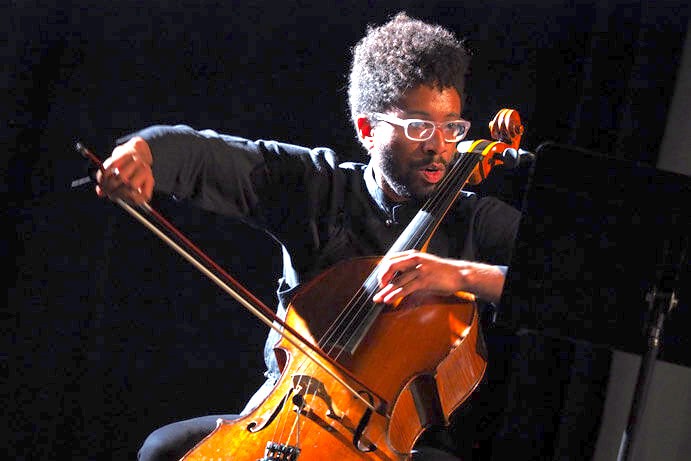
There’s nothing like learning a new word you can use to charming effect in conversation with your friends, co-workers, and dates. Like dehiscence — meaning ‘a splitting open,’ often of a surgical wound.
On second thought, best to leave out the wound aspect and focus on the musical side of the word, thought up by cellist Seth Parker Woods. As he told me during a recent telephone conversation, what interests him is the splitting open of divisions between periods of music. “I’m finding an opening, essentially, and fusing two worlds into one.”
Those worlds are the 17th-century Italian Baroque, and the 20th- and 21st-century avant-garde. He’ll set those genres against each other in “Dehiscence: A Sonic Radicalisation,” a free concert of solo cello music on Tuesday, November 27 at 8:00 pm at LCCC’s Cirigliano Studio Theatre, presented as part of the Signature Recital Series.
The modern works on the program are supplied by Giacinto Scelsi, Claudio Gabriele, and Alvin Singleton, while the much older material comes from Giuseppe Maria Dall’Abaco, Giovanni Battista Vitali, and the always ghostly Anonymous. And while the latter may have been a cellist for all we know, the other composers certainly were, according to Parker Woods. “Perhaps not very prominent ones, but they all played the instrument,” he said.
The music of these two eras is a real passion for Parker Woods. “There’s still lots of experimentation and discovery to be had with them,” he said.
He admitted that the idea of putting old and new in conversation with each other isn’t exactly groundbreaking. “But I wanted to present music that’s quite old, yet already showed signs of clever experimentalism — and then juxtapose it with how far we’ve come, both in the writing and in what the cello can do.”
Whether in tuning or in harmony, that 17th-century experimentalism is often “artfully embedded in the writing,” Parker Woods said. But aside from its adventurousness, the genre has another appeal. “Sometimes you’re listening to these works and you just feel like you’re walking through a piazza, or you’re sitting on the side of a river looking out at some old country — or you’re in Como, and you’re looking out onto the lake,” he said.
A Strings Magazine writer described Parker Woods’ interest in the music of 17th-century Italy as an “obsession.” When I brought that up, the cellist didn’t deny it. “Oh my God, it’s so decadent,” he said. “I came across it some years ago through a friend of mine — a Baroque cellist based in Montreal. And I absolutely fell in love with it.”
Jumping forward a couple centuries, the cellist told me about Alvin Singleton’s Argoru II (1970), the second in a series of three works by the composer for different instruments. “He wrote it while he was in his master’s program at Yale. He takes a simplistic idea, parses it out, and then redesigns it over the course of the work. It’s really exciting, and I’ve found that the piece doesn’t get performed so much. Now I’m really pushing to get it out there, and people are always so receptive to it.”

Tibetan rituals come into play in the 12-minute Triphon (1956) and its shorter, younger brother, the 4-minute Maknongan (1976). Both are by Scelsi, whose conversion to Buddhism notably impacted his writing. “He was trying to take aesthetics and themes from that practice and put them into his works,” Parker Woods said. “You can hear references to Tibetan instruments.”
Triphon also draws on a nifty piece of technology. “The cello is prepared with what’s called a resonator that Scelsi developed back in the sixties,” Parker Woods said. “Basically it’s a copper contraption that sits over the bridge, and when you play two pitches together that are close in range, it expands the overtone series within them. So you get this interesting buzz or interference between the sounds.”
For the other half of my conversation with the Texas-born cellist, we discussed his globe-trotting, European-flavored career. “After studying in New York City and then working there for many years, I decided it was time for a new journey,” he said.
The first stop on that journey was the Hochschule für Musik in Basel, Switzerland, where he also played with the city’s ballet company. “Towards the end of that period, I was also going to Germany — to Freiburg, which is just twenty minutes away on the train. I was studying with Lucas Fels, the cellist from the Arditti Quartet.”
Then, the plan was for Parker Woods to come home. “I thought I was going to teach for two years through that master’s program, and that would be enough for me to get my full feel of Europe. I thought I’d head back to New York and pick up where I left off. But the bug kind of bit me, and I stayed — and lots of doors started opening up in ways I did not plan out when I first signed on to study there.”
After a friend suggested he apply to a Ph.D. program, he put together a proposal and wrote to the University of Huddersfield — in West Yorkshire, near Manchester. “Before I knew it, they were inviting me to visit the campus and meet the department head and some of the other faculty. The day after that meeting, before I’d even flown back to Switzerland, I found out I’d been given this big scholarship.”
Then an opportunity came up to work with the Brussels-based Ictus Ensemble. “I basically started living between two countries,” he said. “I was teaching a heavy load at Huddersfield on top of my own research, and I was creating a program for the new concert season in Belgium, so I had to be in both places in the same week. There would be times when I would finish my courses, go directly to the airport, and get the last flight out to Belgium so I could be there for the morning rehearsal — and then vice versa. So I got to know the border agents really well.”
Logistics aside, it was of course an exciting time for him. “I got to experience very different cultures weekly — on top of touring with the Ensemble, which took me all over Belgium, France, and Italy.” He also made travels to Israel, Palestine, and Portugal for his own performing projects. “And eventually, over the summer of 2014, I took a research exchange trip with my department to Malaysia and Singapore for some teaching and performing. I’d been to Asia many times, but that was my first time in Southeast Asia, which I had always dreamt of seeing.”
After a couple years based in Chicago, Parker Woods is now in Vermont, having joined the faculty at Dartmouth College this year as Visiting Lecturer. And more good news in the States: next concert season, he’ll transition into his post as the inaugural Artist in Residence for the Seattle Symphony’s new concert venue, Octave 9.
Looking back on his fruitful time in Europe, Parker Woods said, “Personally, but also career-wise, it opened a lot of doors, which helped me sustain myself as I made the journey back to the U.S.”
Published on ClevelandClassical.com November 20, 2018.
Click here for a printable copy of this article
Seth Parker Woods:
Music as Choreography
Playing an instrument is, among other things, an action. At a fundamental level, a performance involves a sequence of purposive gestures—a set of intentions embodied in certain movements of the body directed toward the creation of sound. Whether realizing a score or improvising, the performer is engaged in a kind of intelligent choreography involving him or her in a physical exchange with the instrument. As performers and listeners, we often take this physical dimension for granted; notably, though, some musicians have taken it as a conscious point of departure for their own ways of making music.
DANIEL BARBIERO is a Double bassist, sound artist, writer, ailurophile. He lives and works in Washington DC, USA.
The Warmth of Other Suns: Seth Parker Woods, cello
featuring Andrew Rosenblum, piano, and a new commissioned work by Nathalie Joachim Exhibition Concert
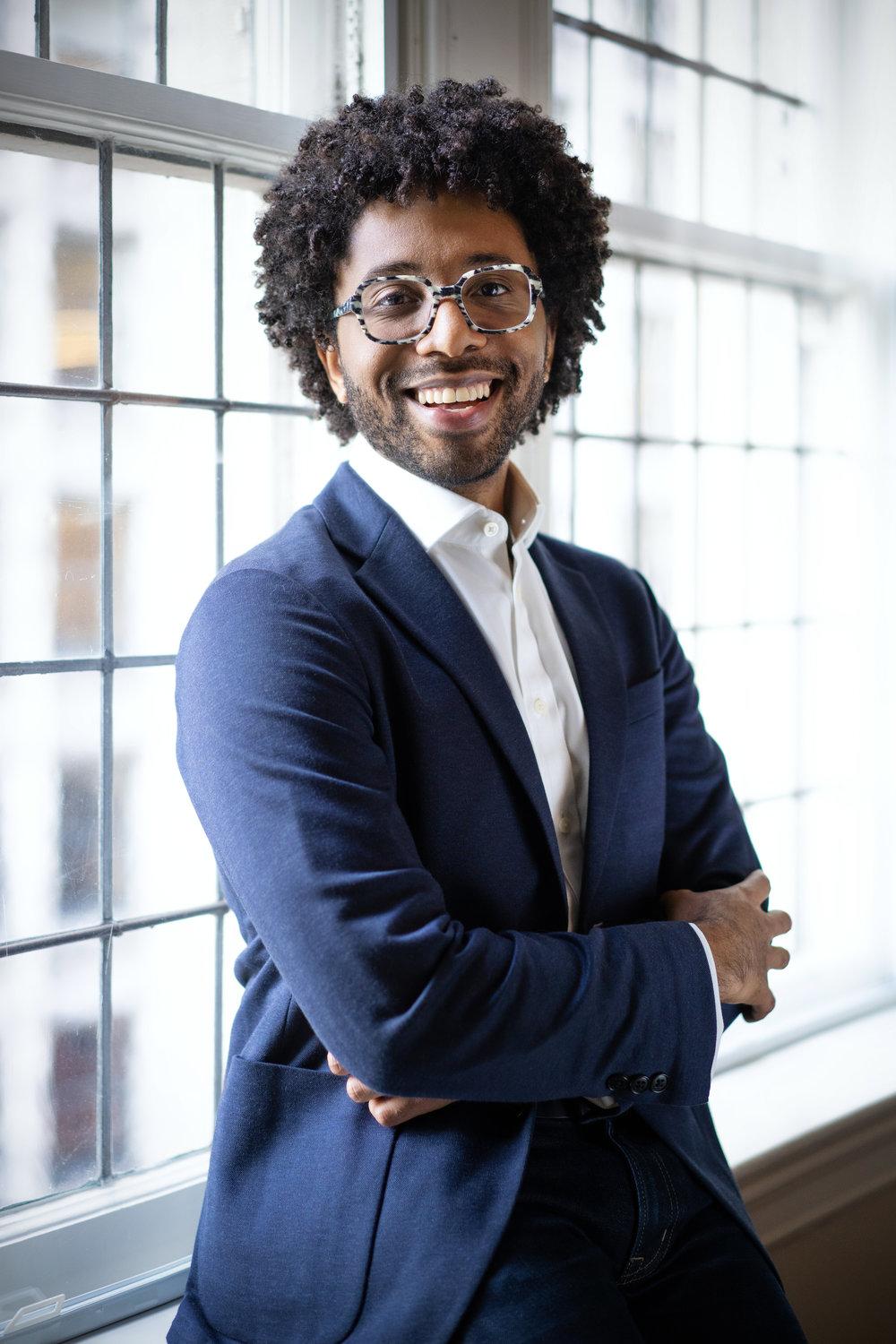
Join us for a pre-season event featuring cellist Seth Parker Woods in conjunction with the exhibition The Warmth of Other Suns: Stories of Global Displacement. Parker Woods will perform a new work inspired by Jacob Lawrence’s Migration Series by Nathalie Joachim, co-commissioned by The Phillips Collection and The Seattle Symphony.
Program
Join us for a pre-season event featuring cellist Seth Parker Woods in conjunction with the exhibition The Warmth of Other Suns: Stories of Global Displacement. Parker Woods presents two Washington, DC, premieres including a new work inspired by Jacob Lawrence’s Migration Series by Nathalie Joachim,
co-commissioned by The Phillips Collection and The Seattle Symphony.
Parker Woods also presents a new work by Cuban-born composer Tania León,
based on the story of the Little Rock Nine, the landmark moment of 1957
that symbolized the fight for desegregation of public schools. Pianist
Andrew Rosenblum joins for George Walker’s Cello Sonata, and Parker Woods completes the program with several works for solo cello, including Coleridge-Taylor Perkinson’s Black/Folk Song Suite, Lamentations, Alvin Singleton’s Argoru II, and a further work by Nathalie Joachim, Dam Mwen Yo, for cello and tape.
PROGRAM:
COLERIDGE-TAYLOR PERKINSON (1932-2004)
Lamentations: Black/Folk Song Suite for Solo Cello
NATHALIE JOACHIM (b. 1983)
Dam Mwen Yo for Cello and Tape (2017)
GEORGE WALKER (1922-2018)
Cello Sonata for cello and piano
ALVIN SINGLETON (b. 1940)
Argoru II (1970) for solo cello
TANIA LEÓN (b. 1943)
New Work (2019) for Solo Cello*
NATHALIE JOACHIM (b. 1983)
The Race for Solo Cello (2019)*
*co-commissioned by The Phillips Collection and The Seattle Symphony
COLERIDGE-TAYLOR PERKINSON (1932-2004)
Lamentations: Black/Folk Song Suite for Solo Cello
*premiere
About the Artists
Hailed by The Guardian as “a cellist of power and grace” who possesses “mature artistry and willingness to go to the brink,” Seth Parker Woods has established a reputation as a versatile artist straddling several genres. In addition to solo performances, he has appeared with the Ictus Ensemble (Brussels, BE), Ensemble L’Arsenale (IT), zone Experimental (CH), Basel Sinfonietta (CH), New York City Ballet, Ensemble LPR, and Orchestra of St. Luke’s (US). A fierce advocate for contemporary arts, Woods has collaborated and worked with a wide range of artists ranging from the likes of Louis Andriessen, Elliott Carter, Heinz Holliger, Georg Friedrich Haas, Helmut Lachenmann, Klaus Lang, and Péter Eötvos to Peter Gabriel, Sting, Lou Reed, Dame Shirley Bassey, and Rachael Yamagata to such visual artists as Ron Athey, Vanessa Beecroft, Jack Early, Adam Pendleton, and Aldo Tambellini.
Holding a PhD from the University of Huddersfield, Woods studied with Thomas Demenga, Lucas Fels, Frederik Zlotkin, and Daniel Morganstern. In recent years he has appeared in concert at the Royal Albert Hall—BBC Proms, Snape Maltings Festival, the Ghent Festival, Musée d’art Moderne et Contemporain, Le Poisson Rouge, Bohemian National Hall, Cafe OTO, Huddersfield Contemporary Music Festival, Klang Festival-Durham, INTER/actions Symposium, ICMC-SMS Conference (Athens, GR), NIME-London, Sound and Body Festival, Instalakcje Festival, Virginia Tech, La Salle College (Singapore), and FINDARS (Malaysia), among others. Recent awards include a DCASE artist grant, Earle Brown/Morton Feldman Foundation Grant, McGill University-CIRMMT/IDMIL Visiting Researcher Residency, Centre Intermondes Artist Residency, Francis Chagrin Award, Concours [Re]connaissance-Premiere Prix, and the Paul Sacher Stiftung Research Scholarship.
His debut solo album, asinglewordisnotenough (Confront Recordings-London), has garnered great acclaim since its release in November 2016 and has been profiled in The Guardian, 5against4, I Care If You Listen, Musical America, Seattle Times, and Strings Magazine, amongst others.
Woods serves on the music faculty at Dartmouth College as a Visiting Lecturer, as well as the inaugural Artist-in-Residence with the Seattle Symphony and their new concert venue, Octave 9.
Andrew Rosenblum, Chicago-based pianist and
harpsichordist, is highly sought-after as both a soloist and
collaborative artist. In May 2017, he won second prize in the
harpsichord category of the 69th annual Prague Spring International
Music Competition. He also won the prize for best performance of Harpsycho
by Petr Wajsar, which was commissioned for the competition. His
2017/2018 season included his conducting debut at the National Gallery
of Art with the New York Opera Society on Gisle Kverdokk’s opera Letters from Ruth,
rehearsal piano work with the Chicago Symphony Chorus and Music of the
Baroque, performances of Monteverdi opera selections with Third Coast
Baroque at the Italian Consulate in Chicago, performances at the Logan
Center for the Arts and PianoForte Chicago as part of the 2017
Ustvolskaya Festival, and recordings of the music of Lori Laitman for
multiple upcoming album releases.
Rosenblum performed as the harpsichord soloist in Bach Brandenburg
Concerto No. 5, with Yo-Yo Ma and the Civic Orchestra of Chicago in
December, 2015. In October and November 2015, he was the pianist for the
Lyric Opera of Chicago’s “Opera in the Neighborhoods” production of Second Nature by Matthew Aucoin, which was performed for 18,000 children in the Chicago area.
Andrew joined the collaborative piano faculty of the Heifetz
International Music Institute in June 2015, returning in the summers of
2016 and 2017. He currently works as a pianist for vocal and
instrumental studios at DePaul and Northwestern Universities, and prior
to moving to Chicago worked as a staff pianist at the Cleveland
Institute of Music, staff pianist for the International Clarinet
Association’s ClarinetFest, rehearsal pianist for the Cleveland
Orchestra Chorus, and choral pianist for Cleveland State University
Choirs. As a rehearsal pianist, he has helped soloists prepare for
concerto performances with many leading orchestras, including the
Minnesota Orchestra, the Cincinnati Symphony Orchestra, and the Detroit
Symphony Orchestra.
Rosenblum has performed in many prominent venues in the US, including
the Kennedy Center and Alice Tully Hall, and has concertized
internationally in Guadalajara, Mexico, Gros Islet, St. Lucia, and
Banff, Canada. His performances include collaborations with Yo-Yo Ma,
Elmar Oliveira, Robert Vernon and Joan Kwoun. His passion for new music
has led him to premiere works by many eminent composers, including Lori
Laitman, Juan Pablo Contreras, and Daniel Wohl. His Trio, Memoria Nova,
founded with violinist Tara Lynn Ramsey and flutist Shanna Gutierrez,
explores connections between musical styles across the spectrum of music
history and had its debut performance at PianoForte Chicago in April,
2017. He maintains a private harpsichord and piano studio in the Chicago
area.
Andrew Rosenblum received his master’s degree in collaborative piano and
harpsichord from the Cleveland Institute of Music, where he studied
with Anita Pontremoli, Peter Bennett, and Janina Ceaser. He currently
studies harpsichord privately with the internationally-renowned
harpsichordist Jory Vinikour.





